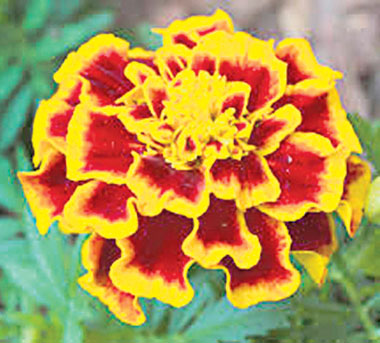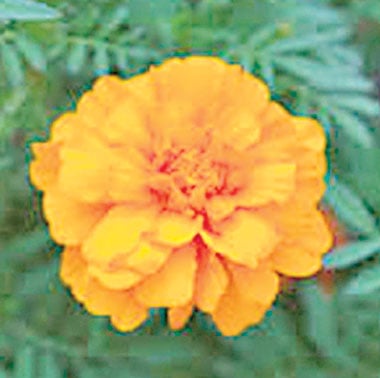A field full of beautiful yellow, orange, gold and red marigold flowers is a sight to behold! Marigolds are beautiful, strong smelling herbaceous flowers that are widely grown throughout the world.
gardening
A field full of beautiful yellow, orange, gold and red marigold flowers is a sight to behold! Marigolds are beautiful, strong smelling herbaceous flowers that are widely grown throughout the world. They appear in the late summer and bloom all through winter season. Marigold belongs to the family Asteraceae and is native of central and South America, especially Mexico and is broadly divided into two groups, African and French marigold. The African marigold grows up-to one metre and above, bears single or fully double large sized globular heads of yellow, orange and white shades, whereas French marigold is dwarf. It grows up to 20-60 centimetres in height and has small, lemon-golden yellow or orange tinged red flowers. These are long lasting and the most easily grown flowers that flourish prolifically in your gardens and balconies. You! finds out how to grow marigolds this winter, and what are its special characteristics that make it the most sought-after plant...
Benefits of marigolds:
Mosquito repellents: Marigolds are beautiful yet very useful. They are effective mosquito repellents as they discourage many insects from feasting on garden plants. If the marigold flower is rubbed on the affected part, it brings relief to pain and swelling caused by a wasp or bee.
For treatment purposes: The flower is useful to treat several foot problems, including bunions, plantar fasciitis and fungal infections. Traditionally, it is used to treat bladder and kidney problems, blood in the urine, uterine bleeding and many more.
Citrusy flavour: It also has culinary value due to its carotenoids content. Dried and crumbled petals are used as a substitute for saffron. Chefs often sprinkle the petals on salad for their citrusy flavour. They also add colour and taste in rice, soups, or stews.
A good ointment: For the treatment of athletes’ feet, varicose veins, nose scabs, eczema, and skin infections, chop some fresh flowers, and add it to coconut oil. Put it to light heat and allow it to cool down. Apply the ointment daily to the affected areas.
Marigold & sunflower oil: To relax tired and aching feet, apply oil made with marigolds and sunflower oil. To make this oil, put 5 tablespoons of petals into a bowl and pour 1 cup of warm sunflower oil. Let the mixture soak for about 4 hours, and then strain the petals through a coarse cloth. The oil is ready to apply but it is appropriate for external use only.
Dyes: Marigolds are also used for extracting some of the colouring dye.
Significance in different cultures:
Marigolds are the symbol of passion, love, charm and brightness. In Indian culture, it symbolises the beginning of new life and good luck. Therefore, it is widely cultivated there to make garlands, for decorative purpose in weddings and festivals. During the religious ceremonies, individuals adorn their vehicles and homes with marigold garlands.
The Aztecs civilization (ethnic groups of central Mexico) considered marigolds as sacred flowers. They were of the belief that marigold relieved one from hiccups and it cured people who were struck by lightning. Also, Mexicans believe that every year in November, dead souls visit the world and marigold flowers guide them towards the earth. Its strong odour is considered as an attraction for dead people. Therefore, in many parts of the world burial sites are adorned with marigolds.
Furthermore, the Welsh believed that if marigolds were not open early in the morning, then a storm was on the way.
Easy to grow:
Want to plant some flowers in your garden? Then marigolds are the best option. The seeds of marigold are quite economical and with little effort, you can create the most interesting and colourful space in your home.
You can grow the plant easily in pots, with well-drained, well-aerated, deep, and fertile soil. Before sowing, make sure to clean the soil from ants because these tiny creatures can carry away the seeds. If they are planted in the ground, you only need to water them if the weather has been very dry for more than two weeks.
Sow the seeds with thin layers of soil in rows and cover with peat moss (easily available in nurseries) or leaves mould compost. Keep the soil moist during this time. The seed starts germination within a week, and seedlings become ready for transplanting after 3-4 weeks.
The right time to transplant comes when the seedling bears 3 to 5 leaves. A thin, long, and older seedling will not give desirable result. Remember to avoid heavy watering to the newly transplanted seedling. Also, in order to get profuse flowering; it is necessary to keep the soil free from weeds.
Once the flowers have fully grown, tweak them in cool hours of the day or during evening.
Almost everyone loves flowers and what they symbolize. And if you are a nature lover, grow marigolds and make your surroundings pleasant and worth living.